 W
WOtorhinolaryngology is a surgical subspecialty within medicine that deals with the surgical and medical management of conditions of the head and neck. Doctors who specialize in this area are called otorhinolaryngologists, otolaryngologists, head and neck surgeons, or ENT surgeons or physicians. Patients seek treatment from an otorhinolaryngologist for diseases of the ear, nose, throat, base of the skull, head, and neck. These commonly include functional diseases that affect the senses and activities of eating, drinking, speaking, breathing, swallowing, and hearing. In addition, ENT surgery encompasses the surgical management and reconstruction of cancers and benign tumors of the head and neck as well as plastic surgery of the face and neck.
 W
WBell's palsy is a type of facial paralysis that results in a temporary inability to control the facial muscles on the affected side of the face. Symptoms can vary from mild to severe. They may include muscle twitching, weakness, or total loss of the ability to move one, and in rare cases, both sides of the face. Other symptoms include drooping of the eyelid, a change in taste, and pain around the ear. Typically symptoms come on over 48 hours. Bell's palsy can trigger an increased sensitivity to sound known as hyperacusis.
 W
WA bone-anchored hearing aid (BAHA) is a type of hearing aid based on bone conduction. It is primarily suited for people who have conductive hearing losses, unilateral hearing loss, single-sided deafness and people with mixed hearing losses who cannot otherwise wear 'in the ear' or 'behind the ear' hearing aids. They are more expensive than conventional hearing aids, and their placement involves invasive surgery which carries a risk of complications, although when complications do occur, they are usually minor.
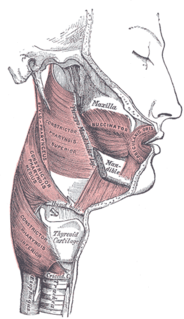 W
WThe buccal space is a fascial space of the head and neck. It is a potential space in the cheek, and is paired on each side. The buccal space is superficial to the buccinator muscle and deep to the platysma muscle and the skin. The buccal space is part of the subcutaneous space, which is continuous from head to toe.
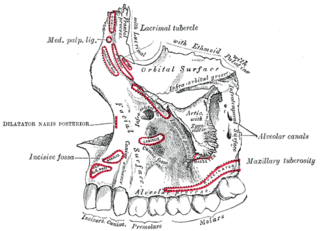 W
WThe canine space, is a fascial space of the head and neck. It is a thin potential space on the face, and is paired on either side. It is located between the levator anguli oris muscle inferiorly and the levator labii superioris muscle superiorly. The term is derived from the fact that the space is in the region of the canine fossa, and that infections originating from the maxillary canine tooth may spread to involve the space. Infra-orbital is derived from infra- meaning below and orbit which refers to the eye socket.
 W
WA cystic hygroma is an abnormal growth that usually appears on a baby's neck or head. It consists of one or more cysts and tends to grow larger over time. The disorder usually develops while the fetus is still in the uterus but can also appear after birth.
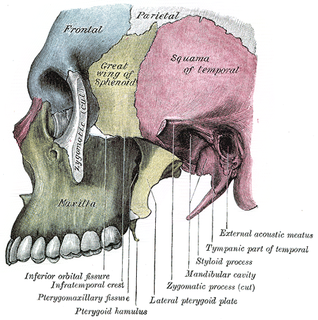 W
WThe deep temporal space is a fascial space of the head and neck. It is a potential space in the side of the head, and is paired on either side. It is located deep to the temporalis muscle
 W
WIdentification of a hearing loss is usually conducted by a general practitioner medical doctor, otolaryngologist, certified and licensed audiologist, school or industrial audiometrist, or other audiometric technician. Diagnosis of the cause of a hearing loss is carried out by a specialist physician or otorhinolaryngologist.
 W
WJames Dundas-Grant KBE, MD, FRCSEd, FRCS was a British ear, nose and throat surgeon. He was surgeon to a number of London hospitals and surgeon to several institutions. He was regarded as a prolific writer about a variety of topics within his speciality and devised a number of surgical instruments. In addition to his clinical practice he was president of several surgical speciality societies and was knighted in 1920.
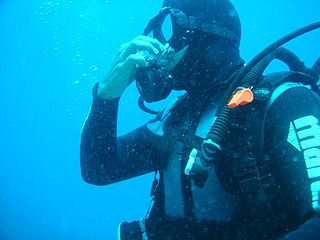 W
WEar clearing or clearing the ears or equalization is any of various maneuvers to equalize the pressure in the middle ear with the outside pressure, by letting air enter along the Eustachian tubes, as this does not always happen automatically when the pressure in the middle ear is lower than the outside pressure. This need can arise in scuba diving, freediving/spearfishing, skydiving, fast descent in an aircraft, fast descent in a mine cage, and being put into pressure in a caisson or similar pressure-bearing structure, or sometimes even simply travelling at fast speeds in an automobile.
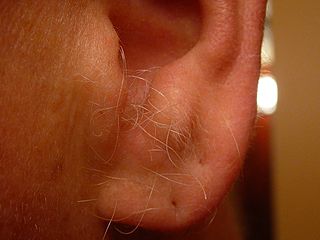 W
WEar hair is the terminal hair arising from folliculary cartilage inside the external auditory meatus in humans. In its broader sense, ear hair may also include the fine vellus hair covering much of the ear, particularly at the prominent parts of the anterior ear, or even the abnormal hair growth as seen in hypertrichosis and hirsutism. Medical research on the function of ear hair is currently very scarce.
 W
WFacial nerve paralysis is a common problem that involves the paralysis of any structures innervated by the facial nerve. The pathway of the facial nerve is long and relatively convoluted, so there are a number of causes that may result in facial nerve paralysis. The most common is Bell's palsy, a disease of unknown cause that may only be diagnosed by exclusion of identifiable serious causes.
 W
WThe frontal sinuses are one of the four pairs of paranasal sinuses that are situated behind the brow ridges. Sinuses are mucosa-lined airspaces within the bones of the face and skull. Each opens into the anterior part of the corresponding middle nasal meatus of the nose through the frontonasal duct which traverses the anterior part of the labyrinth of the ethmoid. These structures then open into the semilunar hiatus in the middle meatus.
 W
WFunctional endoscopic sinus surgery (FESS) is a minimally invasive surgical treatment which uses nasal endoscopes to enlarge the nasal drainage pathways of the paranasal sinuses to improve sinus ventilation. This procedure is generally used to treat inflammatory and infectious sinus diseases, including chronic rhinosinusitis that doesn't respond to drugs, nasal polyps, some cancers, and decompression of eye sockets/optic nerve in Graves ophthalmopathy.
 W
WHead and neck cancer is a group of cancers that starts in the mouth, nose, throat, larynx, sinuses, or salivary glands. Symptoms for head and neck cancer may include a lump or sore that does not heal, a sore throat that does not go away, trouble swallowing, or a change in the voice. There may also be unusual bleeding, facial swelling, or trouble breathing.
 W
WA head mirror is a simple diagnostic device, stereotypically worn by physicians, but less so in recent decades as they have become somewhat obsolete.
 W
WHuman papillomavirus-positive oropharyngeal cancer, is a cancer of the throat caused by the human papillomavirus type 16 virus (HPV16). In the past, cancer of the oropharynx (throat) was associated with the use of alcohol or tobacco or both, but the majority of cases are now associated with the HPV virus, acquired by having oral contact with the genitals of a person who has a genital HPV infection. Risk factors include having a large number of sexual partners, a history of oral-genital sex or anal–oral sex, having a female partner with a history of either an abnormal Pap smear or cervical dysplasia, having chronic periodontitis, and, among men, younger age at first intercourse and a history of genital warts. HPV-positive OPC is considered a separate disease from HPV-negative oropharyngeal cancer.
 W
WThe Infratemporal space is a fascial space of the head and neck. It is a potential space in the side of the head, and is paired on either side. It is located posterior to the maxilla, between the lateral pterygoid plate of the sphenoid bone medially and by the base of skull superiorly. The term is derived from infra- meaning below and temporal which refers to the temporalis muscle.
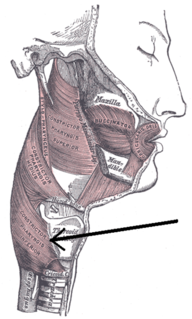 W
WKillian's dehiscence is a triangular area in the wall of the pharynx between the cricopharyngeus and thyropharyngeus which are the two parts of the inferior constrictors(also see Pharyngeal pouch). It can be seen as a locus minoris resistentiae. Similar triangular area between circular fibres of cricopharyngeus and longitudinal fibres of esophagus is Lamier's triangle or Lamier-hackermann's area.
 W
WThe mental space is a fascial space of the head and neck. It is a potential space, bilaterally located in the chin, between the mentalis muscle superiorly and the platysma muscle inferiorly. These spaces may be created by pathology, e.g., the spread of odontogenic infection. Commonly the origin of the infection is an anterior mandibular tooth with associated periapical abscess which erodes through the buccal cortical plate of the mandibular at a level below the attachment of the mentalis muscle.
 W
WMicrosurgery is a general term for surgery requiring an operating microscope. The most obvious developments have been procedures developed to allow anastomosis of successively smaller blood vessels and nerves which have allowed transfer of tissue from one part of the body to another and re-attachment of severed parts. Microsurgical techniques are utilized by several specialties today, such as: general surgery, ophthalmology, orthopedic surgery, gynecological surgery, otolaryngology, neurosurgery, oral and maxillofacial surgery, plastic surgery, podiatric surgery and pediatric surgery.
 W
WThe neck dissection is a surgical procedure for control of neck lymph node metastasis from squamous cell carcinoma (SCC) of the head and neck. The aim of the procedure is to remove lymph nodes from one side of the neck into which cancer cells may have migrated. Metastasis of squamous cell carcinoma into the lymph nodes of the neck reduce survival and is the most important factor in the spread of the disease. The metastases may originate from SCC of the upper aerodigestive tract, including the oral cavity, tongue, nasopharynx, oropharynx, hypopharynx, and larynx, as well as the thyroid, parotid and posterior scalp.
 W
WOral cancer, also known as mouth cancer, is cancer of the lining of the lips, mouth, or upper throat. In the mouth, it most commonly starts as a painless white patch, that thickens, develops red patches, an ulcer, and continues to grow. When on the lips, it commonly looks like a persistent crusting ulcer that does not heal, and slowly grows. Other symptoms may include difficult or painful swallowing, new lumps or bumps in the neck, a swelling in the mouth, or a feeling of numbness in the mouth or lips.
 W
WOxybuprocaine (INN), also known as benoxinate or BNX, is an ester-type local anesthetic, which is used especially in ophthalmology and otolaryngology. Oxybuprocaine is sold by Novartis under the brand names Novesine or Novesin.
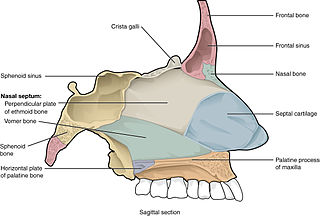 W
WParanasal sinus and nasal cavity cancer is a cancer that is caused by the appearance and invasion of malignant cells into the paranasal sinus which constructs the hollow and Oxygen-filled areas in bones of nose and tissue called nasal cavity which constructs the tissue above the bones of the mouth top and the front throat. Meanwhile, the major age group of the cancer is between 50–70 years old. It was also found that the number of male patients are twice larger than female patients. During the early phase of the cancer, the symptoms could be nasal obstruction, hyposmia, etc. Other symptoms will also appear as further growth of malignant cells and invasion of into other human tissue such as palate, orbital floor continuing. The head X-rays test and neck MRI could make contribution to the diagnosis of the cancer while normal surgery, radiation therapy and chemotherapy can be utilized for the treatment of the cancer.
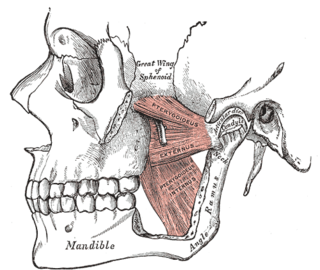 W
WThe pterygomandibular space is a fascial space of the head and neck. It is a potential space in the head and is paired on each side. It is located between the medial pterygoid muscle and the medial surface of the ramus of the mandible. The pterygomandibular space is one of the four compartments of the masticator space.
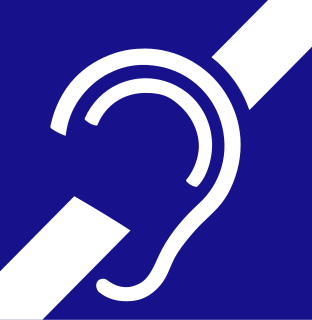 W
WHearing loss is a partial or total inability to hear. Hearing loss may be present at birth or acquired at any time afterwards. Hearing loss may occur in one or both ears. In children, hearing problems can affect the ability to learn spoken language, and in adults it can create difficulties with social interaction and at work. Hearing loss can be temporary or permanent. Hearing loss related to age usually affects both ears and is due to cochlear hair cell loss. In some people, particularly older people, hearing loss can result in loneliness. Deaf people usually have little to no hearing.
 W
WReconstructive surgery is a term with training, clinical, and reimbursement implications. It has historically been referred to as synonymous with plastic surgery. In regard to training, Plastic Surgery is a recognized medical specialty and a surgeon can be a "board-certified" plastic surgeon by the American Board of Plastic Surgery. However, reconstructive surgery is not a specialty and there are no board-certified reconstructive surgeons.
 W
WA facelift, technically known as a rhytidectomy, is a type of cosmetic surgery procedure used to give a more youthful facial appearance. There are multiple surgical techniques and exercise routines. Surgery usually involves the removal of excess facial skin, with or without the tightening of underlying tissues, and the redraping of the skin on the patient's face and neck. Exercise routines tone underlying facial muscles without surgery. Surgical facelifts are effectively combined with eyelid surgery (blepharoplasty) and other facial procedures and are typically performed under general anesthesia or deep twilight sleep.
 W
WThe sublingual space is a fascial space of the head and neck. It is a potential space located below the mouth and above the mylohyoid muscle, and is part of the suprahyoid group of fascial spaces.
 W
WThe submandibular space is a fascial space of the head and neck. It is a potential space, and is paired on either side, located on the superficial surface of the mylohyoid muscle between the anterior and posterior bellies of the digastric muscle. The space corresponds to the anatomic region termed the submandibular triangle, part of the anterior triangle of the neck.
 W
WThe submasseterric space is a fascial space of the head and neck. It is a potential space in the face over the angle of the jaw, and is paired on each side. It is located between the lateral aspect of the mandible and the medial aspect of the masseter muscle and its investing fascia. The term is derived from sub- meaning "under" in Latin and masseteric which refers to the masseter muscle. The submasseteric space is one of the four compartments of the masticator space. Sometimes the submasseteric space is described as a series of spaces, created because the masseter muscle has multiple insertions that cover most of the lateral surface of the ramus of the mandible.
 W
WThe submental space is a fascial space of the head and neck. It is a potential space located between the mylohyoid muscle superiorly, the platysma muscle inferiorly, under the chin in the midline. The space coincides with the anatomic region termed the submental triangle, part of the anterior triangle of the neck.
 W
WSurgical airway management is the medical procedure ensuring an open airway between a patient’s lungs and the outside world. Surgical methods for airway management rely on making a surgical incision below the glottis in order to achieve direct access to the lower respiratory tract, bypassing the upper respiratory tract. Surgical airway management is often performed as a last resort in cases where orotracheal and nasotracheal intubation are impossible or contraindicated. Surgical airway management is also used when a person will need a mechanical ventilator for a longer period. The surgical creation of a permanent opening in the larynx is referred to as laryngostomy. Surgical airway management is a primary consideration in anaesthesia, emergency medicine and intensive care medicine.
 W
WTracheal intubation, usually simply referred to as intubation, is the placement of a flexible plastic tube into the trachea (windpipe) to maintain an open airway or to serve as a conduit through which to administer certain drugs. It is frequently performed in critically injured, ill, or anesthetized patients to facilitate ventilation of the lungs, including mechanical ventilation, and to prevent the possibility of asphyxiation or airway obstruction.
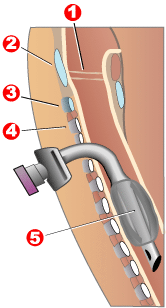 W
WTracheotomy, or tracheostomy, is a surgical procedure which consists of making an incision (cut) on the anterior aspect (front) of the neck and opening a direct airway through an incision in the trachea (windpipe). The resulting stoma (hole) can serve independently as an airway or as a site for a tracheal tube or tracheostomy tube to be inserted; this tube allows a person to breathe without the use of the nose or mouth.